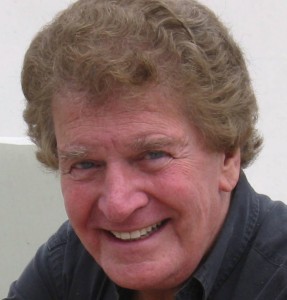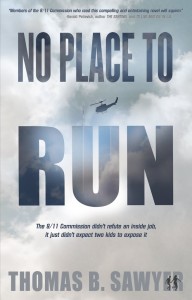 The Kill Zone is pleased to welcome novelist, screenwriter, and playwright Thomas B. Sawyer. Thomas was Head Writer/Show runner of the hit CBS series, Murder, She Wrote, for which he wrote 24 episodes. Tom has written 9 network TV pilots (100 episodes), and was Head Writer/Show runner or Story Editor on 15 network TV series. The best-selling thriller, The Sixteenth Man, was his first novel. Both his book, Fiction Writing Demystified, and Storybase are Writer’s Digest Book Club Selections. His latest thriller is No Place to Run. He has taught writing at UCLA and other colleges and universities. He has been nominated for an Edgar and an Emmy.
The Kill Zone is pleased to welcome novelist, screenwriter, and playwright Thomas B. Sawyer. Thomas was Head Writer/Show runner of the hit CBS series, Murder, She Wrote, for which he wrote 24 episodes. Tom has written 9 network TV pilots (100 episodes), and was Head Writer/Show runner or Story Editor on 15 network TV series. The best-selling thriller, The Sixteenth Man, was his first novel. Both his book, Fiction Writing Demystified, and Storybase are Writer’s Digest Book Club Selections. His latest thriller is No Place to Run. He has taught writing at UCLA and other colleges and universities. He has been nominated for an Edgar and an Emmy.
The fact that I came to narrative fiction in reverse from most writers – in that I began as a screenwriter – afforded me more than a few attitudes. And definitely not least was/is on the topic of dialogue attribution.
In novels and short stories I had long been struck by what I regard as the rampant, mindless use of “he said,” “she said,” “said he” and the like. I know that many highly regarded and/or successful writers and teachers regard such usage as a kind of pinnacle of simplicity. I agree, but not in the affirmative sense of “simple.”
As I began to contemplate my first venture into the form, I began to think about such things more seriously. Why, I wondered, would experienced, quality writers who otherwise (rightly) bust their humps to avoid using clichés, surrender to these without guilt? Or, viewed another way, when does a particular phrase cease being “economical,” and morph into a cliché?
And how many millions of trees, I asked myself, have given their lives for such conceits?
And how many millions of trees, I asked myself, have given their lives for such conceits?
To me, even worse – no, make that dumber – is “she asked.” It’s dumber because, since it so often follows a question mark, the reader knows it’s a question, right? So why repeat it?
And then there are “he blurted,” “she exclaimed,” “he queried,” etc. If you must attribute, rather than committing those atrocities, I guess “he said” begins to look attractive.
Almost.
Did I have a solution? Yeah. When I set out to write my first novel, THE SIXTEENTH MAN, I set as a goal/challenge for myself – a little secret bar-raising, if you will – that I would never use any of those phrases. Ever. Nor, actually, any direct attribution – and yet maintain clarity for the reader. The result? While hardly revolutionary – I’ve since learned that numerous novelists do it – I’m convinced that it has made my writing better, more readable, and certainly more visual.
Here’s my approach, and the way I teach it.
Work on attribution the way you work on the rest of your writing, with the care you give to your dialogue and your descriptions. Will it make a dramatic difference to your readers? Not likely. Will they even be aware of it? Probably not. Especially on a conscious level. But – will it make a difference to you as a writer? Emphatically, yes. It’ll force you to think. To challenge yourself about stuff from which most narrative writers take the day off. So that all of your writing will become fresher.
Work on attribution the way you work on the rest of your writing, with the care you give to your dialogue and your descriptions. Will it make a dramatic difference to your readers? Not likely. Will they even be aware of it? Probably not. Especially on a conscious level. But – will it make a difference to you as a writer? Emphatically, yes. It’ll force you to think. To challenge yourself about stuff from which most narrative writers take the day off. So that all of your writing will become fresher.
And, in the process, I found that it contributed to finding my “voice.”
It also contributed to some criticism from certain literary types who warned me that as a novelist I could not “write for the camera.” I submit that they are mistaken. The reader is the camera. The reader is seeing the pictures. Imagining the scene.
Think about conventional, by-the-numbers dialogue attribution for a moment. “She said,” does almost nothing to help the reader envision the scene. It says nothing about the body-language of the speaker, or her inflection. Where were her hands? Was her head cocked to one side? Did she, during the speech, touch her face, or the person to whom she spoke? For me, settling for “said” implies that the speaker is delivering lines with arms hanging at his/her side. Again, for me as a reader, a brief description of body-language counts for a helluvva lot more than knowing what the person is wearing, or hair-color, or the texture of sofa-upholstery.
It also contributed to some criticism from certain literary types who warned me that as a novelist I could not “write for the camera.” I submit that they are mistaken. The reader is the camera. The reader is seeing the pictures. Imagining the scene.
Think about conventional, by-the-numbers dialogue attribution for a moment. “She said,” does almost nothing to help the reader envision the scene. It says nothing about the body-language of the speaker, or her inflection. Where were her hands? Was her head cocked to one side? Did she, during the speech, touch her face, or the person to whom she spoke? For me, settling for “said” implies that the speaker is delivering lines with arms hanging at his/her side. Again, for me as a reader, a brief description of body-language counts for a helluvva lot more than knowing what the person is wearing, or hair-color, or the texture of sofa-upholstery.
Admittedly, noting such detail isn’t always important, but when it helps the reader “see” the action, it seems to follow that it will also help the reader “hear” the words. In my own case, as with most-but-not-all writers, when it’s obviously clear for the reader which character is speaking, I omit attribution. But when the speaker is gesturing to emphasize a point, or is revealing, say, insecurity or anger or even an emotion that contradicts his or her words, that is worth communicating to the reader. Further, when a character’s response to another’s words isn’t spoken, but is rather a gesture, a look, that can be good storytelling.
I think of it as directing my actors – just as in my scriptwriting, describing when necessary those actions that augment their speeches – or – as in non-verbal responses – replace them entirely.
I urge any writer to try it. I think you’ll be pleasantly surprised.
~~~~~~~~~~~~~~~~~~~~
Coming up on our Kill Zone Guest Sundays, watch for blogs from Sandra Brown, Steve Berry, Robert Liparulo, Paul Kemprecos, Linda Fairstein, Julie Kramer, Grant Blackwood, and more.

